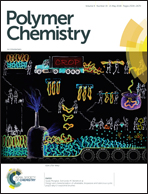Tuning the hydrophobic cores of self-immolative polyglyoxylate assemblies†
Abstract
Polyglyoxylates are a recently-introduced class of self-immolative polymers, that depolymerize to small molecules upon the cleavage of a stimuli-responsive end-cap from the polymer terminus. The incorporation of different pendant ester groups or other aldehyde monomers offers the potential to tune the polymer properties, but this remains largely unexplored. With the goal of tuning the self-assembly and drug-loading properties of polyglyoxylate block copolymers, we explored the polymerization and copolymerization of n-butyl glyoxylate, L-menthyl glyoxylate, and chloral with ethyl glyoxylate to form UV light-responsive polyglyoxylates. The resulting polymers were coupled to poly(ethylene glycol) to afford amphiphilic block copolymers. Self-assembly of the different copolymers was studied and although each system formed solid particles, the cores of the assemblies differed in their stability, hydrophobicity, and their ability to load the hydrophobic drug celecoxib. All systems depolymerized and released the drug in response to UV light. The toxicity profiles for the assemblies were also evaluated using MDA-MB-231 cells. Overall, this work demonstrates that the properties of polyglyoxylates and their assemblies can be readily tuned through the incorporation of new monomers, thereby providing a promising platform for drug delivery and other applications.



 Please wait while we load your content...
Please wait while we load your content...